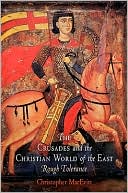

 |

|

The average rating for The Crusades and the Christian World of the East: Rough Tolerance based on 2 reviews is 4 stars.
Review # 1 was written on 2017-03-24 00:00:00 Andrew Latimer Andrew LatimerDigging back into OUTREMER research, this time with a book investigating an area I've been needing to learn about for a long time: just what did local Armenian, Syrian, and Greek Christians think of the Frankish newcomers when they unexpectedly arrived in the Levant at the turn of the twelfth century? I was familiar with the two basic schools of thought. Nineteenth century historians and modern Roman Catholic apologists depict a world of idyllic colonial harmony in which Frankish crusaders travelled East primarily for the benefit of the eastern church, and benevolently ruled them once they got there. Twentieth century historians, on the other hand, insist that the Franks lived lives starkly segregated from, and unsympathetic to, local Christians. At worst, populist writers claim, eg, that "Many [Eastern Christians] found the intolerant singlemindedness of the new Latin regimes a harsh change from the arrangements under the pragmatic Islamic rule" - then neglect to provide any references to substantiate the same. In Rough Tolerance Christopher MacEvitt provides a series of fairly convincing arguments that, in the twelfth century at least, this was not the case. Boundaries between Latins, Greeks, Syrians, and Armenians were highly permeable. The Franks, no doubt by virtue of their small numbers and reliance on local authority structures to keep their new principalities alive, had no choice but to accept everyone as Christian who claimed to be, to treat Eastern peasants with more respect than their own serfs in the West, and to include Easterners even at high levels of government and the military. Locals named their children after Franks (footnotes refer to "Arnulf {north French name} son of Bernard {south French name}, the Syrian" and also to "Sade {Said}, ra'is {judge} of the Saracens of Acre, and his brother William". One Syrian family, the Arrabis, provided the kingdom of Jerusalem with several generations of knights. MacEvitt's conclusion is that in the twelfth century, the Franks succeeded in engaging with locals on a personal and regional basis, rather than dividing along ideological lines to create an us-versus-them mentality. In practice, this meant that individual Franks could on occasion treat locals badly, or individual locals could on occasion make life difficult for the Franks, without causing sectional strife. Ironically, it may have been Manuel I Comnenus's attempts to achieve ecumenical union that destroyed this "rough tolerance". By seeking to impose a single definition of faith on the Armenian and Syrian churches, he may have actually caused all three local Christian traditions to circle wagons around their ideological distinctives. This was a thoroughly well-researched, scholarly book that was also well-written and engaging, and answered a whole lot of my questions about the role of local Christians in the Crusader States, while confirming a lot of my hunches based on my previous research. |
Review # 2 was written on 2017-03-20 00:00:00 William Ramos William RamosMacEvitt introduces the concept of "rough tolerance" to situate his work between camps that viewed the treatment of local Christians by the crusaders as either tolerant or oppresive. He leans heavily into the assimilationist camp, but tempers this view with the violence that the franks occasionally used against their subjects. The culture of silence is stressed here: the latins did not attempt to divide up their subjects, and local Christians did not compile lists of Latin crimes. The crusaders did not target whole groups, in contrast to the contemporary west that was categorizing heretics and Jews, and instead integrated some of them and lived with the rest of them. This all came apart in the 1160s, though, as Byzantine attempts to reconcile the eastern churches with Constantinople broke the silence and brought differences to the surface. |
CAN'T FIND WHAT YOU'RE LOOKING FOR? CLICK HERE!!!